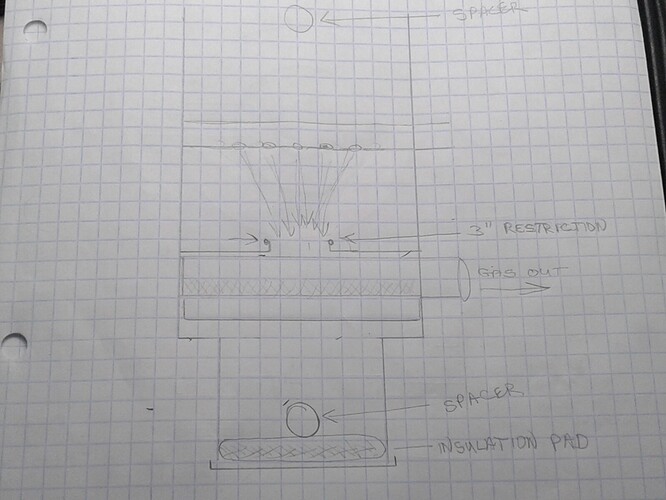Yes, what Don said. I have a 2.5 L engine. What size engine would you use?
With the flat plate restriction just above the gas out pipes it could be raised up if needed, and the size of the restriction can be change to what we need for the engine displacement. I have notice about a 3 plus hole being used for smaller engines. I think I will make mine rectangle to match up with the flute design nozzles, but I sure it doesn’t really matter that much going through the reduction zone.
Pipe for the flute nozzles. Thick walled pipe. 11/2" . 5 nozzle holes in each flute.
The out let pipes do not need to be heavy walled, 2" pipe should keep the gases moving at a slower velocity and keep the vaccum restriction down. Lots of small holes, may be use a screen
No less than 3" between the flute nozzles pipes, and the nozzles hole point slightly downward. I want to get away from having to screen and making the charcoal a certain size. I want to cook the wood to charcoal hit with a shovel get the ash out use it. Let the gasifer do the work.
I need to go to the Amy surplus store and check out the ammo box sizes we have to work with.
I am thinking on using this new idea that Joni has come up with. The vacuum exhaust in the top of the hopper to remove extra moisture.
Bob
Bob, are you talking wood or charcoal now when you reference a restriction and moisture removal?
I am thinking no less than 8 to 10 inches between nozzle pipes. That super hot lobe will melt the other nozzle pipe if too close even if pointed slightly downward.
For a 2.5l engine at 3500 rpm, roughly 1/3rd of the displacement volume comes through the nozzles.
I use a flange and a jet ring. This is way easier to construct no jets needed. Sort of like I had at Argos. Same basic reactor design with some new iterations since then.
Might be worth your while to have a shop CNC cut those parts.
Hi Don, I am planning on using mainly charcoal with a little wood mixed in to give it the moisture for the charcoal to absorb. I have a yard chipper to make the wood fuel. No sorting the chips just mix it up with the charcoal and bag it and use it. KISS.
Okay 8" to 10" between flute nozzles. Thanks Don.
Here is one most drawing.
Like I before I need to find out what size ammo boxes are available for me to use.
Keeping the nozzles holes closer together on the flute pipe will help with heat problems on the ammo box. If I can find a way to put a box with in a box this will give me a way to pre heat my incoming air to the nozzles.
In side the gas out pipes I think I will cut out a large opening from the pipes slide the screen inside and wege it in with a another pipe slightly smaller diameter. So far no welding required.
Bob
So here is the reactor for a build Im working on now.
This first pic set is the reduction skirt and housing. The char filled inner skirt and the grate hang bellow it. Gas then enters outside and flows up housing then out a side port exhaust.

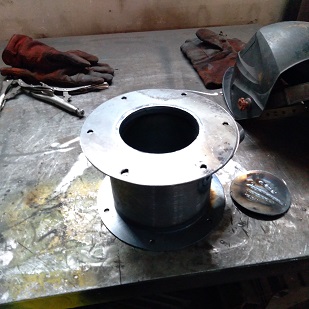
This next pic is the reactor core. The air intake is built around the hearth core. There is a glow plug for auto ignition, the main air feed and then the port for the water spray that is aimed directly at the restriction. The air and resulting steam mix then flows up through the slot array at the top. Then the jet ring is placed and sandwiched between the hearth core and the hopper flange to cap it off. Hopper flange is not shown, (not built yet).

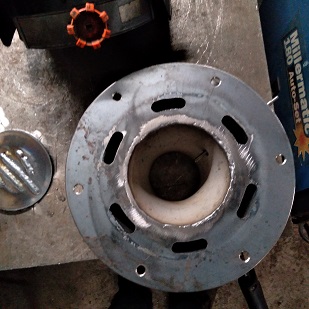
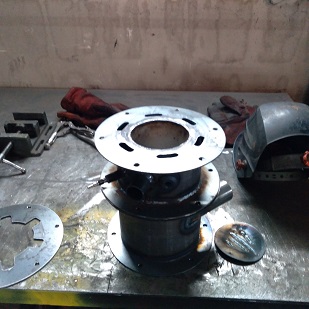


I can change out that jet ring and adjust the gap openings to fine tune.
Hi Matt very informative design. Question: if you made your ring spacer with the out side holes slotted, so you could move your ring back and forth opening the air passages more or less there would be no reason to change out the spacer ring. Just losses the bolts and make your adjustments with tearing it all down removing the hopper and everything else attached to it. What you are showing here is a big improvements over what I saw at the last Argos Wood Gas Meet Up.
Bob
We actually just had those same thoughts yes we can make that ring to adjust this way.
only issue, is yes you can control the volume, however the opening would still be static so velocity would decrease as you closed this off.
BTW you are all welcome to use and share this design. It is now public domain, just dont sell it.
Okay Matt, how about 2 plates and move them in opposite directions equally. This might give the nozzles opening a funny air flow patterns.
Bob
Yup now your thinking. No I think it would actually work fine. Part of this design is so the air has a gap between where it exits the rings and reaches the fuel. So it is impossible for heat degradation of the rings.
I am watching this thread with great interest. I can not claim to be even 14% as busy as Kristijan, (I still suspect he can continue working in his sleep) but I am bummed that I have too much on my plate to take on another build. Matt, that is a great looking design, what is the size of the engine it is going to power?
Once my electric truck is built, I will need to get a better woodgas generator sorted out (that counts as driving on wood, right?) I really think downdraft charcoal units are going to be a game changer - I am looking forward to seeing all the innovations you guys come up with, and I look forward to having the time to contribute something to the cause.
Edit: For anyone who is interested, I put a link to my truck project in my profile.
Design intent is to run a range from 200 cc on up to 700 cc ish. lol Wont know until we build and try it though.
Yeah as I was reading about your truck, Im thinking where is the thread?? Yes if you intend to charge it on renewables and wood gas is a part of that. Then yes it counts!!! lol And you will be a pioneer in it. I dont see why you couldn’t. Very cool you are doing this and I cant wait to see this.
Ha, l leave the site for a day and there is a flood of new ideas 
Guys, slow down! Have we forgoten what the charcoal gasifier is all about? Simplicity! I think this is geting way to complicated, at least for a start.
As Bruce sayd, first lets determine engine size. It is important to realise that this is not your tipical simple fire that can run engines from 50 to 2000cc, this needs to be reasonably tuned in with the engine. And most importantly, like a wood gasifier, not be too big!
Specialy if mixing wood with charcoal is the goal!
Lets talk restriction first. I may have been unclear before. A “restriction” can be a lot of things. I wuld strongly advise aginst any clasical “ring” restriction. I like to build my charcoal gasifiers bullet proof so that they can survive the worst abuse possible, even runing on dry charcoal without any way to lower the tempeature. A clasical metal ring will not survive period.
In adition, the reactor with 2 oposite flilutes has a squere or potentialy elongated “hell zone”. Might not be pairable with a round restriction.
So, whats more refractive thain metal? Well, charcoal has a 6600f “melting” point sooo… why not use that?
For a start l propose this
I propose we take a rectangular container, ammo box maybee, and drill the holes for the flutes near the the wall like on the skech. But we make a exact fit! The flute protruding trugh both sides.
The flute then drilled with holes gets hammered in tightly trugh the container. This way a weldless construction and future modifications, like tilting nozzles up/down or offset/direct blowing can be achived with just a pair of plumbers thongs. A tight metal to metal fit is more thain tight enaugh for the purpose.
Even if drilling right to the wall is not possible and there is a gap between the back side of the flute and the wall, a bit of glass fibre insulation can be shoved in the gap and then a bit of ash poured on top, seal guaranteed. Avoid metals as much as possible, KISS 
On the bottom lays a perforated metal tube as the grate. I had good resaults with useing that as gas outlet/grate in my updraft gasifiers, shuld work here too.
As for the restriction, remember where a WK has the restriction. At the very end! Thats a huge advantige as the gases cool down till they come there, unlike a lmbert wich puts the restriction in the center of hell.
This is what is achived here too.
This “ashcone” will form naturaly as it does in a wood gasifier, forming a self repairing “restriction”
So what do you say guys? Anyone in for a quick test? Its a one hour gasifier after all 
Woo Hoo! Now we are talking simple again. I have had a piece of expanded stainless steel in my woodstove’s “hell zone” for years. Kristijan, can you give us your thoughts on dimensions for a 2.5 liter engine? Number of nozzle holes, size and distance from reactor vessel wall and distance from grate?
My thoughts are 4 x 10mm holes 25mm apart in each flute with insulation 12.5mm beyond holes giving 100mm “hell zone.” Distance between flutes? 250mm? Distance between flutes and expanded grate/outlet? 250mm?
The key to a restriction is never expose an edge. You must use a funnel so the heat can dissipate. This is unless you are using extremes heavy thick materials. The reason those SS reducers work is because they irregular in shape. They can displace without stress. verses a straight cone will displace in a linear direction and stress crack, leak, melt and fail.
I have been using these cones for 8 years built hundreds of machines and pushed them to the limits, They are indestructible you can not destroy them in a gasifier.
The cores I am showing are for an $8000.00 machine. It is not supposed to be simple. It is modular design so parts can be replaced making the machine last basically for ever. This is an advanced hybrid design intent is to run on charcoal and a mixture. That restriction is there for a number of reasons. One to to focus heat for external water heat to flash steam and the other is to ensure tars for raw fuel media never make it past this reactor core.
My goals are not the same as most. This is not a charcoal gasifier, it is thermal water cracking device that uses charcoal as the heat source. This is a change of perspective 
Yes but l was reffering to the double flute gasifier. The goal here is to design a durable downdraft gasifier that is allso simple to make. And if possible free 
I like it. Period. 20 characters…
Ah but I have a CNC Machine Hahaha!! Yeah its really not all that complicated, I can build that from raw steel in less than a couple of hours. It takes more time to make existing things work than it does to just make it from scratch for me anyways. We started out cutting tanks and things, and grinders are a no go here. We very rarely use a grinder any more.
Bruce, l fear having nozzles just a inch apart might be too much for the flute, specialy since its not in its original upward position. I think l wuld not risk geting them under 2" apart.
One of the reasons l started designing the flute in the first place was to make the gasifier longer and narrower. Perhaps this might allso be possible here, later. (Just a intermezzo)
My Mercedes had a 2.3l engine so a 2.5 is close enaugh. From the top of my head, transforming one gasifier in a nother, l wuld say 4 holes (8mm for a start, can be drilled latger later if too much drag occurs) 2" apart for a 8" hell zone of “, flutes being 8” apart or 10" apart if only moist charcoal is to be burnt (no wood).
Now for the height to the grate, l think l had about 6" from nozzles to the grate and it was just a tad on the small size so l wuld say 8 or 9". 10 might be pushing it (we dont like the “dead charcoal” above the grate to start plugging with fines and ash) althugh a 10" tall gasifier might preety much give it unlimited drawing ability.
Oh, Bob, l forgot before. Dont worry too much about hopper fumes. As long as your charcoal is engine grade-ish size, it will block all heat riseing up in the hopper. No heat, no smoke from toasting wood peaces. Whatever moisture that does sneak up will just reabsorbed in the charcoal.
